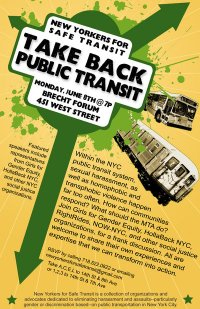It is important that transit planners and operators identify and accept the specific safety needs of women and girls. Many times, women cannot afford or do not have access to private modes of transportation such as cars and taxis. Thus, women’s choices for safe and accessible means of transportation are frequently limited. Economic power imbalances and socio-cultural constraints may increase women’s dependence on public transit, yet the public transit available may not meet their needs. Furthermore, these imbalances and constraints increase women's insecurity and vulnerability in relation to their movement throughout their environments. For instance, while using public transit, women’s feelings of insecurity stem from their experiences of and fear of sexual harassment and violence while waiting for public transportation, or while walking to and from public transportation stops. The recognition of the distinct types of barriers that women face while moving throughout their environment is a fundamental first step to making transit safe for women and girls.
Specific examples of barriers to safe public transit for women and girls include:
- Experiences and fear of sexual harassment and violence while walking to and from transit, while waiting for public transit, and while using public transit.
- Overcrowding, lack of space and the fact that women are often carrying things (children, parcels, merchandise, etc.), make female passengers more vulnerable to harassment (Peters, 1998, 3).
- Difficulty getting to and from public transit due to distance and/or unsafe routes/transit locations.
- Difficulty paying for transit passes, especially when trips with multiple destinations require multiple transit fares.
- Inability getting to and from destinations due to inadequate transit routes.
- Eliminated, reduced or more expensive service to less-lucrative routes and connections upon which women depend as a result of the privatisation of public transit (Peters, 1999).
- Limited access to private motorized forms of transportation, e.g. cars, and intermediate modes of transport, e.g. bicycles, whether because of economic power imbalances, socio-cultural constraints and/or lack of time (Peters, 1999).
CaseStudy: New Yorkers for Safe Transit (NYFST)
New Yorkers for Safe Transit is a group of like-minded organizations who are working together to make public transportation in New York City more inclusive and safe for women and other groups who face discrimination. NYFST runs a website which documents press coverage of sexual harassment and similar crimes on the city’s transit system. In addition, the website provides readers with information and resources on taking action against violence and discrimination. NYFST has also organized media campaigns to raise awareness about safety on public transit.
Moreover, NYFST has developed a series of activities to generate information about violence and discrimination in New York City transit. For example, in September 2008, NYFST members presented a testimonial to the Metropolitan Transit Authority (MTA) and the New York Police Department (NYPD), requesting that systems be developed to receive and track information about complaints related to sexual harassment on transit. The testimonial also suggested that gender be included as a question on passenger feedback forms, so that the MTA could assess whether women feel more insecure using transit than men.
In January 2010, NYFST held its first focus group discussion with survivors of harassment and assault on the New York Transit system. The focus group discussion allowed participants to talk about their experiences and make suggestions for eliminating such incidents in the future.

Case Study: Blank Noise “Eve Teasing” List.
In India, sexual harassment is often referred to as ‘eve teasing’, which only serves to trivialize the issue. The Blank Noise Project invited women to share their personal experiences of sexual harassment on the city’s public transportation. Based on the responses they received, the compiled an extensive list of the different manifestations of ‘eve teasing’ experienced by the women as they move through the city. The responses yielded a number of examples ranging from: whistling, staring, talking to breasts, passing comments, ‘accidentally’ touching, flashing, stalking, tickling, masturbating, unsolicited photography, spitting, honking, and being followed. The response that Blank Noise received from this activity served to demonstrate the type and extent of harassment barriers women face on public transit in India.
See Blank Noise. (no date). Blank Noise Blog. Available in English.
Resources:
The Public Transport Gender Audit (2002). This checklist tool allows public employees, researchers, government officials, and women's organizations to assess how their public transportation performs in relation to women's needs. A series of 135 questions cover a range of topics from personnel policies to women's participation in planning services. The checklist is based on experience in the United Kingdom, but could be adapted to other contexts. Available in English.